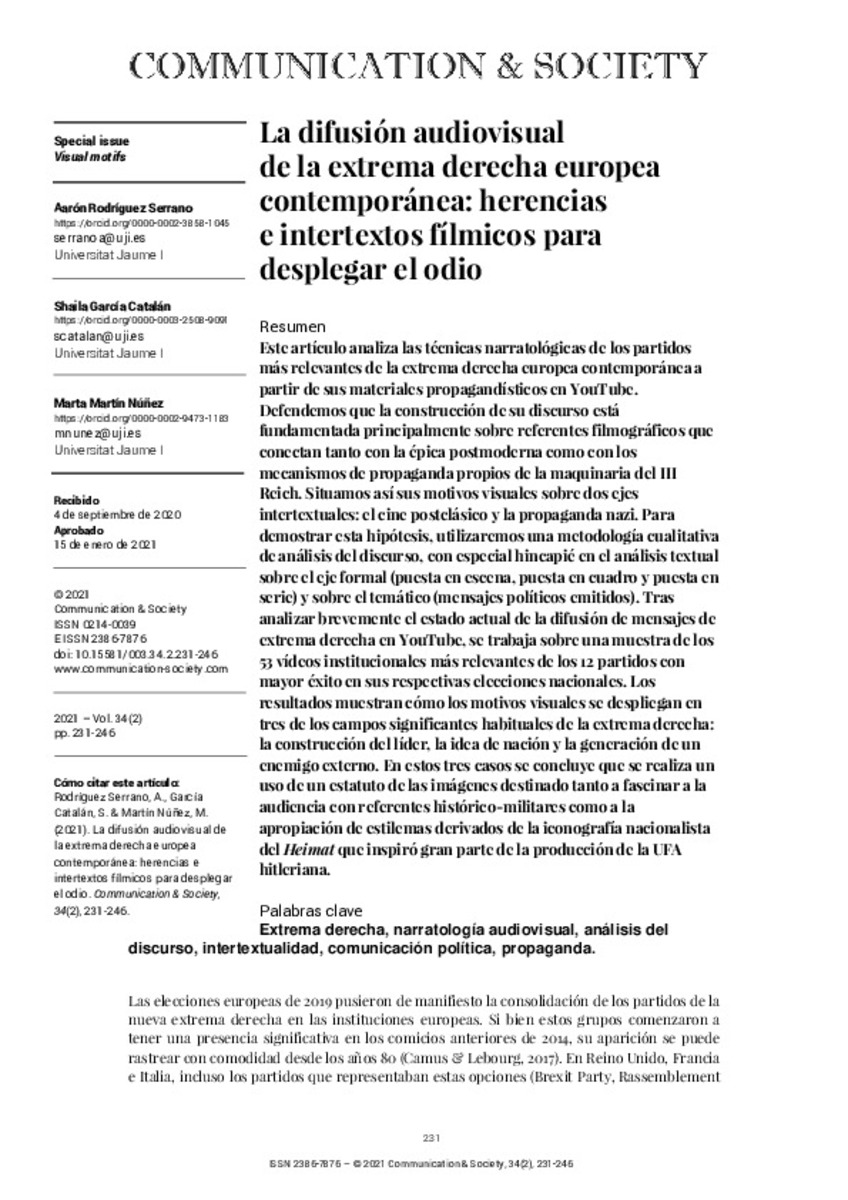Full metadata record
| DC Field | Value | Language |
|---|---|---|
| dc.creator | Rodríguez-Serrano, A. (Aarón) | - |
| dc.creator | García-Catalán, S. (Shaila) | - |
| dc.creator | Martín-Núñez, M. (Marta) | - |
| dc.date.accessioned | 2021-04-13 | - |
| dc.date.accessioned | 2021-10-22T07:02:05Z | - |
| dc.date.available | 2021-10-22T07:02:05Z | - |
| dc.date.issued | 2021 | - |
| dc.identifier.citation | Rodríguez-Serrano, A. (Aarón); García-Catalán, S. (Shaila); Martín-Núñez, M. (Marta). "Audiovisual Production by the Contemporary European Extreme Right: Filmic Inheritances and Intertexts to Spread the Hate". Communication & Society. 34 (2), 2021, 231 - 246 | es |
| dc.identifier.issn | 2386-7876 | - |
| dc.identifier.uri | https://hdl.handle.net/10171/62248 | - |
| dc.description.abstract | This article analyses the narrative techniques of major far-right political parties in contemporary Europe, based on their promotional videos on YouTube. It argues that the construction of their discourse is based mainly on cinematic references that connect with both the post-modern epic and the propaganda machinery of the Third Reich. Their visual motifs are thus positioned on two intertextual axes: post-classical cinema and Nazi propaganda. To support this hypothesis, a qualitative methodology of discourse analysis is applied, with special emphasis on the textual analysis of both formal features (staging, framing, and editing) and thematic content (the political messages conveyed). After offering a brief outline of the current state of the dissemination of right-wing extremist messages on YouTube, the article examines a sample of 53 of the most important institutional videos by the 12 far-right parties that have been most successful in their respective national elections. The results confirm that their visual motifs evoke three of the most characteristic fields of signification of the extreme right: the construction of the leader, the idea of nation, and the creation of an external enemy. In all three cases, a series of images is used with the aim of both captivating the audience with historical-military references and appropriating stylistic features from the nationalist iconography of the <em>Heimat</em>, which inspired many of the UFA films of the Nazi era. | en_US |
| dc.description.abstract | Este artículo analiza las técnicas narratológicas de los partidos más relevantes de la extrema derecha europea contemporánea a partir de sus materiales propagandísticos en YouTube. Defendemos que la construcción de su discurso está fundamentada principalmente sobre referentes filmográficos que conectan tanto con la épica postmoderna como con los mecanismos de propaganda propios de la maquinaria del III Reich. Situamos así sus motivos visuales sobre dos ejes intertextuales: el cine postclásico y la propaganda nazi. Para demostrar esta hipótesis, utilizaremos una metodología cualitativa de análisis del discurso, con especial hincapié en el análisis textual sobre el eje formal (puesta en escena, puesta en cuadro y puesta en serie) y sobre el temático (mensajes políticos emitidos). Tras analizar brevemente el estado actual de la difusión de mensajes de extrema derecha en YouTube, se trabaja sobre una muestra de los 53 vídeos institucionales más relevantes de los 12 partidos con mayor éxito en sus respectivas elecciones nacionales. Los resultados muestran cómo los motivos visuales se despliegan en tres de los campos significantes habituales de la extrema derecha: la construcción del líder, la idea de nación y la generación de un enemigo externo. En estos tres casos se concluye que se realiza un uso de un estatuto de las imágenes destinado tanto a fascinar a la audiencia con referentes histórico-militares como a la apropiación de estilemas derivados de la iconografía nacionalista del <em>Heimat</em> que inspiró gran parte de la producción de la UFA hitleriana. | es_ES |
| dc.language.iso | eng | - |
| dc.publisher | Servicio de Publicaciones de la Universidad de Navarra | es_ES |
| dc.rights | info:eu-repo/semantics/openAccess | es_ES |
| dc.subject | Extrema derecha | - |
| dc.subject | narratología audiovisual | - |
| dc.subject | análisis del discurso | - |
| dc.subject | intertextualidad | - |
| dc.subject | comunicación política | - |
| dc.subject | propaganda | - |
| dc.title | Audiovisual Production by the Contemporary European Extreme Right: Filmic Inheritances and Intertexts to Spread the Hate | en_US |
| dc.type | info:eu-repo/semantics/article | es_ES |
| dc.identifier.doi | 10.15581/003.34.2.231-246 | - |
| dadun.citation.endingPage | 246 | - |
| dadun.citation.number | 2 | - |
| dadun.citation.publicationName | Communication & Society | - |
| dadun.citation.startingPage | 231 | - |
| dadun.citation.volume | 34 | - |
Statistics and impact
Items in Dadun are protected by copyright, with all rights reserved, unless otherwise indicated.







